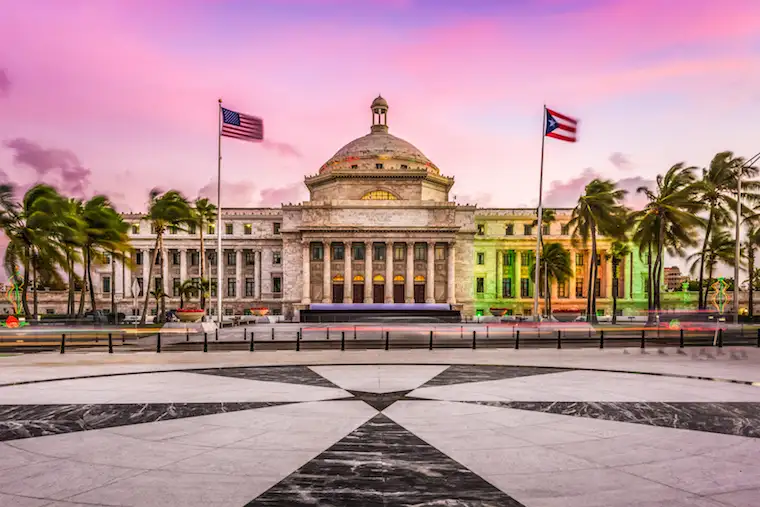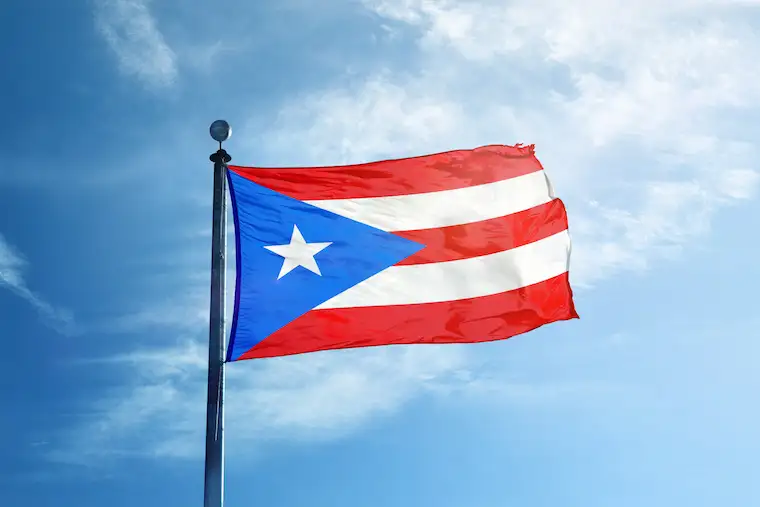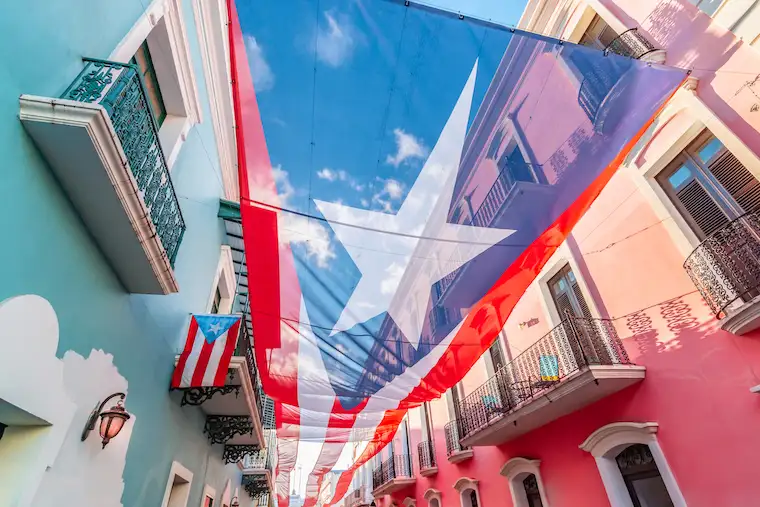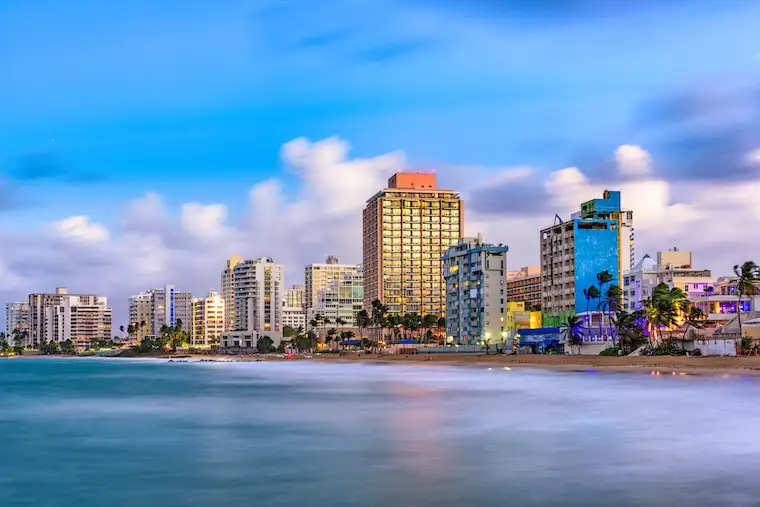Banks in Puerto Rico are often perceived to be an “easier-to-access” option than those in the mainland USA or other mid-tier financial centers around the world.
For many, the view is that banks in Puerto Rico offer all the benefits but require jumping through fewer hoops than their US counterparts. And, while that can sometimes be true, it’s not always the case.
Feel free to jump ahead to the areas most relevant to you by using the table of contents below.
Table of Contents
- Overview of Banks in Puerto Rico
- Who Can Open Offshore Accounts With Banks in Puerto Rico?
- Act 20, Act 22, and Act 60 Considerations
- Why Do People Want to Bank in Puerto Rico?
- What Is the “American” EMI?
- What You Need to Know About Banking in Puerto Rico
- Unique Pros & Cons of Banks in Puerto Rico
- Choosing Between Banks in Puerto Rico
- Frequently Asked Puerto Rico Banking Questions
- Ready to Unlock the Benefits of International Banking?
Overview of Banks in Puerto Rico
Banks in Puerto Rico offer some comparable services to certain US banks. However, for non-residents, US banks may be more desirable after considering the available options in Puerto Rico. This is especially true since many US banks are larger, more accessible, and offer more benefits than banks in Puerto Rico.
In this article, we’re going to talk about the benefits, challenges, and risks associated with banks in Puerto Rico. We’re also going to discuss who should consider banking here. And, we’ll also share some alternative jurisdictions that may be better suited to certain client types.
First, it’s important to note that certain “banks” in Puerto Rico are accessible to non-resident foreigners. We’re going to share what this means, how to avoid the pitfalls, and which banks non-residents can access later in the article.
But, it’s also worth noting that most of the benefits of banking in Puerto Rico (including remote account opening) are entirely accessible to non-resident foreigners at US banks as well… as long as you have the right information and know which specific banks (and bankers) to approach.
In fact, if you’re already a member of GlobalBanks USA you can start opening accounts with banks in Puerto Rico and the United States 100% remotely right now.
If you’re not a member of GlobalBanks USA keep reading to learn how you can start opening accounts with banks in Puerto Rico today.
Do You Want to Explore All Your Offshore Banking Options?
Who Can Open Offshore Accounts With Banks in Puerto Rico?
Puerto Rico is one of those unique banking jurisdictions that can offer a ton of value to certain clients and should be avoided (if possible) by others. In other words, if you need to bank here, you should. But, if you don’t need to bank here, there are better options available elsewhere.
Those who typically consider banking in Puerto Rico are the usual suspects: investors, residents, and anyone doing business locally. But, you’ll also notice another customer group that is unique to Puerto Rico: Act 20 and Act 22 (and now Act 60) participants. We’ll discuss these in some detail below.
Client Types That Can Open an Account With a Bank in Puerto Rico:
- Individuals and businesses investing in Puerto Rico
- Tourists frequently visiting Puerto Rico
- Individuals that own a business in Puerto Rico
- Owners of real estate in Puerto Rico
- Participants in Act 20, Act 22, and Act 60
- Non-residents that desire a USD account (that can’t open in the US)
Most of these client groups are self-explanatory. If you plan on having local business or financial activities, open a local bank account. It’s that simple. Of course, the process to choose the best bank in Puerto Rico might not be so straightforward. We’ll discuss this in more detail in the next section.
But, for now, let’s take a look at some of the considerations related to Puerto Rico’s incentive programs (Act 20, Act 22, and Act 60). Again, this is a specific client type that is unique to Puerto Rico.
Act 20, Act 22, and Act 60 Considerations

In recent history, Puerto Rico made a name for itself after introducing incentive programs to attract foreign entrepreneurs and investors to the island. This includes Act 20 and Act 22, which were introduced in 2012.
These two pieces of forward-looking legislation allowed direct tax agreements to be signed with the Puerto Rican government. In doing so, they essentially eliminated personal tax liabilities and drastically reduced corporate tax liabilities to 4%. Not too shabby.
In 2019, Act 20 and Act 22 were merged and amended into a new incentive program, Act 60.
Act 60 did reduce some of the available incentives but it’s still very attractive for anyone looking to reduce their tax burden. Also, anyone who moved to Puerto Rico under Act 20 and Act 22 was grandfathered into their pre-existing agreements.
There are, of course, individual requirements to maintain such a favorable tax status. Not the least of which is being a bona fide resident, living on the island six months of the year, etc.
And, with white sand beaches, crystal clear water, and palm tree-laden streets, it’s pretty idyllic. Just skip hurricane season.
Obviously, there are other requirements to meet if you signed on for any of these incentive programs, including opening a local bank account. But, this is just one of the reasons banks in Puerto Rico have been pushed into the limelight… let’s take a look at some of the other reasons now.
Why Do People Want to Bank in Puerto Rico?

Yes, there are additional reasons to consider banks in Puerto Rico beyond satisfying the requirement of a residency program. But, as we’ll share, Puerto Rico might not be the best place to unlock these benefits.
Here’s a quick overview of some of the catalysts driving account openers to the island:
- Demand for non-CRS banking as CRS goes global
- Increasing scrutiny of non-resident banking elsewhere
- Promotion of Puerto Rico as a residency jurisdiction
- Prevalence of non-resident options via IFEs (discussed below)
1. Demand for Non-CRS Banking as CRS Goes Global
Opening bank accounts in countries that do not participate in the Common Reporting Standards (CRS) is sometimes seen as a way to increase privacy. In other words, banks in non-CRS jurisdictions don’t automatically share account information with tax authorities in your home country.
This is a very flawed “strategy” for increasing privacy on many levels. Not to mention the fact that almost all countries that do not participate in CRS should be avoided when it comes to banking (with a few limited exceptions). Additionally, every year, more and more countries sign on to participate in CRS. So, available non-CRS options are quickly disappearing.
We discuss non-CRS countries and opening accounts with this objective in mind in our CRS Guide and Non-AEOI article on our website. If you’re interested in learning more about CRS and information sharing in general, these are two great resources to start with.
But nonetheless, Puerto Rico’s status as a US territory gives it non-CRS status and this is a common reason why people want to open accounts with banks in Puerto Rico.
But, banks in Puerto Rico are not the only option if you’re looking for non-CRS banking. The United States also does not participate in CRS. So, if you’re looking for non-CRS banks, you may actually have more options than you think.
2. Increasing Scrutiny of Non-Resident Banking Elsewhere
Similar to how CRS is becoming the norm in the banking world, so too is the clampdown on non-resident banking. More specifically, bank regulators everywhere are imposing stricter restrictions and stiffer penalties on banks for non-resident banking infractions. This has especially been an issue in Europe.
But, one place where non-residents are still welcomed to open accounts is Puerto Rico. Of course, the same is still true for the United States.
In any case, the acceptance of non-resident account holders by some banks in Puerto Rico has been a catalyst for the growing interest in non-resident account opening here.
3. Promotion of Puerto Rico as a Residency Jurisdiction
Banking in Puerto Rico makes perfect sense if you’re there on Act 20, Act 22, Act 60, or Act 273 (which we’ll discuss in a minute).
But for everyone else, meaning foreign non-residents of Puerto Rico, there is absolutely no reason to bank there. Unless, of course, you’ve exhausted all your US banking options and desperately want a backup bank account in Puerto Rico for a specific reason.
In other words, and this is key, Puerto Rico is a residency jurisdiction, not a banking jurisdiction.
Like other residency jurisdictions, those who acquire residency via Puerto Rico’s special programs must open a bank account as part of their requirements. But, in doing so, most people only open the accounts they need to meet the residency requirements… and that’s it.
So, why has Puerto Rico become such a hotbed for non-resident banking?
4. Prevalence of Non-Resident Banking Options via IFEs
To understand the non-resident banking options available via IFEs we first need to discuss Act 273. Basically, Act 273 offers the same benefits as Act 20, Act 22, and Act 60 with one important difference, you get to set up your own bank.
Well, technically speaking, you set up an “International Financial Entity”, or an IFE. But, for all intents and purposes, an IFE is a bank. It’s a financial entity that can take and manage deposits on behalf of customers.
Not surprisingly, many IFEs have started springing up with the influx of wealthy Americans, investors, and entrepreneurs, due to favorable legislation.
And why not? Move to a beautiful Caribbean island, reduce your taxes, and open your own bank in the process. Sounds like a great way to spend a weekend.
But, while an IFE is certainly an interesting proposition for the founder, it may not be the best option for customers.
And, naturally, many of the entrepreneurs setting up IFEs are business owners with a vested interest in promoting the benefits of Puerto Rico as a safe and credible banking jurisdiction.
In other words, a growing number of IFEs are promoting the perceived benefits of banks in Puerto Rico… regardless of whether or not IFEs and banks in Puerto Rico are deserving of the promotion.
But, what exactly is an IFE? We’ll take a closer look in the next section of the article.
What Is the “American” EMI?
Currently, the US does not have an Electronic Money Institution (EMI) license like those offered in the UK and many European countries. But, the IFE in Puerto Rico is pretty damn close.
There are of course some important differences, including the fact that IFEs can transact directly through the Fed (after approval), which we’ll discuss below.
But, in most instances, IFEs operate as pure digital banks. In fact, many are attempting to offer similar services to their European counterparts and US fintechs.
Additionally, like EMIs and fintechs, IFEs also have shortcomings. These include not having deposit insurance, less oversight and regulation compared to big box banks, and generally looser operating requirements compared to banks (and fintechs) elsewhere.
Of course, if you choose well-run IFEs with sound balance sheets, transparent operations, and strong correspondent banking relationships, this might not matter to you in the first place.
What You Need to Know About Banking in Puerto Rico

There are essentially three “types” of banks in Puerto Rico. These include commercial banks, international banking entities (predecessor to IFEs), and the already mentioned international financial entities.
For reference, while IFEs are the most recent of the available options (only coming to existence in 2012), they have quickly become the most numerous. For a recent list of all active license holders, you can visit the website of the Puerto Rican regulator.
Types of Banks in Puerto Rico (Number Registered)
- Commercial Banks (7)
- International Banking Entities (27)
- International Financial Entities (53)
If you do require an account with a bank in Puerto Rico (which suggests you’re a local resident or have a tie to Puerto Rico) then the commercial banks will probably be your first choice.
However, foreigners who are non-residents of Puerto Rico will typically only be able to access IBEs and IFEs. These entities focus exclusively on international clients and offer services and products tailored to international client needs.
Are Banks in Puerto Rico Considered US Banks?
Regardless of whether you’re considering opening with a commercial bank or an IBE/IFE account, you might be wondering what relation banks in Puerto Rico have to the US and vice versa.
First and foremost, Puerto Rico is not a US state. It’s an unincorporated US territory. This means Puerto Rico has the same status as other US territories. These include the US Virgin Islands, Guam, American Samoa, and the Northern Mariana Islands.
So, technically, banks in Puerto Rico are not US banks. But, they do share some of the benefits while also having unique challenges.
Unique Pros & Cons of Banks in Puerto Rico

IFEs are able to open accounts with the US Federal Reserve, more specifically the Federal Reserve Bank of New York. This essentially makes IFEs clients of the New York Fed.
But, since IFEs are not US banks, they don’t have any requirement to insure deposits with the US Federal Deposit Insurance Corporation (FDIC). So, any deposits you maintain with IFEs in Puerto Rico are not subject to deposit insurance. On the other hand, commercial bank deposits do benefit from FDIC insurance. However, it’s unlikely that non-residents are going to be able to open accounts with these banks.
That said, many Puerto Rico IFEs boast a 100% deposit ratio. This means, unlike most banks in the world, they do not engage in high-risk commercial lending, which should result in much safer banking. Of course, you need to verify this with each bank you’re considering and also account for other risk factors.
Lastly, similar to US banks, IFEs and banks in Puerto Rico are not subject to Common Reporting Standards (CRS). So, clients looking for a bit more privacy (and to avoid CRS) might find IFEs and banks in Puerto Rico interesting.
Though, as we’ve covered at length in past articles, there are other mechanisms for information sharing beyond CRS and true banking privacy no longer exists.
Choosing Between Banks in Puerto Rico
With nearly 90 IFEs and banks in Puerto Rico to choose from, determining which one is best for you can be a challenge. But, like most places, the banks themselves will help you narrow down your options quickly. That’s because, in many instances, non-residents won’t be able to open accounts in the first place.
In fact, IBEs and IFEs often have specific parameters that only allow them to open for certain clients. For instance, some IFEs are unable to market their services to the public. Others can only serve a specific client or member group. And, other IFEs consistently refuse certain citizenships and residencies.
Of course, this isn’t the case for all banks and IFEs. And, in certain instances, non-resident foreigners can open accounts. So, the question then becomes how to choose which banks in Puerto Rico are best for you?
To start, you should be looking for banks that offer the specific benefits that you’re interested in. And, when considering banks in Puerto Rico, these usually include the following:
Account Opening Considerations:
- 100% remote account opening
- USD denominated accounts
- Cater to non-resident foreigners
- Limited lending activities (at some IFEs)
- Access to SWIFT, Fedwire, and FedACH (at some banks IFEs)
- Increased privacy by banking in a non-CRS jurisdiction
Note: These same benefits and advantages (and more) are accessible through banks in the US. In fact, with the right information, account opening strategies, and contacts you can open US bank accounts 100% remotely as a non-resident foreigner. These options are immediately available when you join GlobalBanks USA. So, with this in mind, before applying to open with banks in Puerto Rico, you may want to consider opening with banks in the US instead.
Frequently Asked Puerto Rico Banking Questions
Below are a few of the most common questions we receive from people exploring how to open a Puerto Rico bank account. If you have further questions about online offshore banking, don’t hesitate to contact us directly.
What Banks Are Both in Puerto Rico and the United States?
The bank that operates both in Puerto Rico and the United States is Banco Popular. Also known as Popular Bank in the United States.
Can a Foreigner Open a Bank Account in Puerto Rico?
Yes, a foreigner can open a bank account in Puerto Rico as long as they meet the bank’s account opening requirements and have a suitable client profile. That said, bank selection will be an important factor to consider when opening accounts here as not all banks in Puerto Rico accept foreigners.
What Bank is Popular in Puerto Rico?
The bank that is popular in Puerto Rico is Banco Popular, also known as Popular Bank Inc. In fact, Banco Popular is one of the largest financial institutions operating in Puerto Rico.
Ready to Unlock the Benefits of International Banking?
If you’re seeking better banking options, diversification, or enhanced privacy—our International Account Opening Service is your fastest, most effective path forward.
Trusted by high-net-worth-individuals and 8-figure businesses, it’s a fully personalized solution backed by real experts, with real results.
Here’s what you can expect:
✅ Direct support from our international banking experts—so you’re never stuck guessing what to do next.
✅ Prequalification with banks that match your profile and actually want you (or your business) as a customer.
✅ Custom strategies to overcome any challenges and help you open the accounts you need—whether you’re a non-resident, entrepreneur, investor, or global citizen.
✅ Personal introductions to banks that perfectly match your profile (not random suggestions you have to cold-call yourself).
✅ Answers to tough questions about documentation, compliance, and what works in today’s evolving banking climate.
✅ Guaranteed account opening because we will keep working with you until you successfully open the bank account you need.
And yes—GlobalBanks’ International Account Opening Service is purpose-built for foreign and non-resident individuals and companies.
But, spots are limited and we only accept qualified applicants—so if you’re ready to move forward, take 60 seconds to complete your free assessment.

